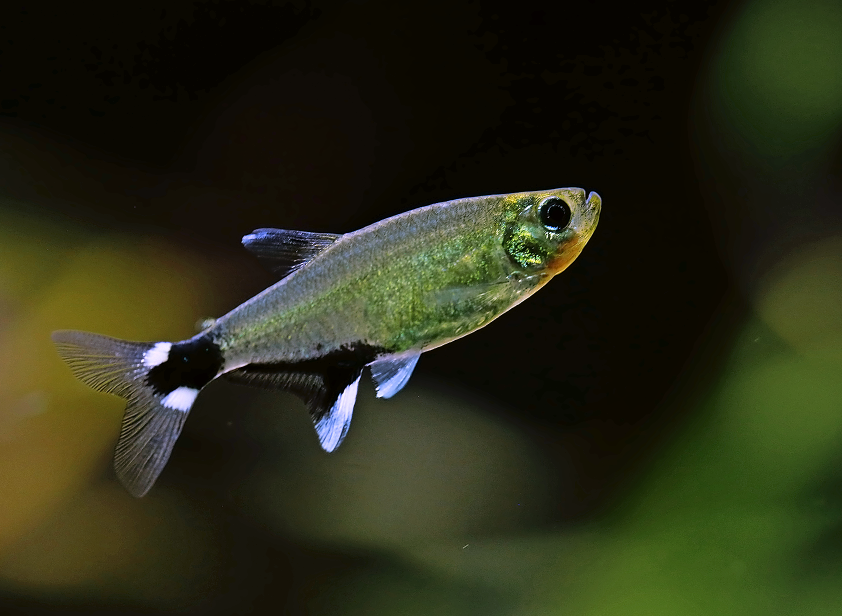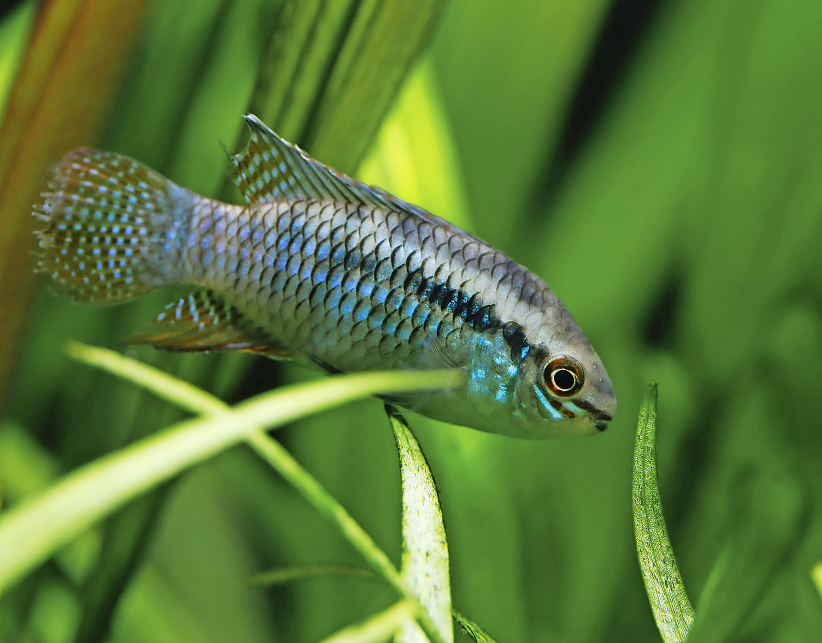Blackwater streams in Colombia and Peru have inspired this 'forest shadows' set-up.
An aquarist who travels the world and builds tanks based on where he’s been is inspiring. What’s even better is when he shares those tanks with the rest of us...
WORDS: TAI STREITMAN. PHOTOGRAPHY: GEORGE FARMER
Looking around at the hobby today, I feel it’s fair to say that for many fishkeepers, the days of plain aquarium gravel, a few plastic plants and a novelty treasure chest air-stone have been left behind. High tech aquascapes, biotopes and complex reef systems have all entered the hobby and changed our perspectives on what is feasible, what is available and what is ethical.
There are those who will never relinquish plastic plants, shipwrecks and a diverse community, and that’s fine — each to their own. As long as fish are healthy and quality of life is maintained, people can put whatever they like in their tanks.
My own feeling is that for a little effort, we can create displays that not only prioritise the wellbeing of our fish, but also look beautiful and natural. Looking online or at some of the incredible aquascapes that appear in this magazine can be daunting, but a bit of research and patience can provide even the beginner with an engaging and successful set-up.
 Nannostomus marginatus.
Nannostomus marginatus.
Forest shadows
I’m a huge fan of blackwater set-ups. If it looks like tea, I’m in. These set-ups aren’t hard to create, although maintaining water quality and stability are important. Using lots of wood and leaf litter produces tannins that stain the water and lower the pH. Also, believe it or not, they’ll bring out the colours of many species more spectacularly than crystal clear water.
Many of our popular characins, dwarf cichlids, rasbora and gourami species will all thrive in blackwater set-ups that mimic their natural environments. I was lucky enough to explore blackwater streams in Colombia and Peru and they have inspired me to create a small blackwater community with species found in the Amazon basin.
I have used a 90cm/36in, 100 l/22 gal tank and Catappa leaves (easily bought online) and a stash of dried finger palm fronds that actually come from the gorilla enclosure at London Zoo!
You can just as easily use beech or oak leaves and it’s worth collecting a few bags in the autumn and storing them in a dry space for use as and when you need them. Amazon frogbit, Limnobium laevigatum, and Salvinia natans provide cover for the fish and with those aerial roots they suck up spare nutrients.
I wanted to have activity at all levels and my choice of fish reflects this. At the top, Giant hatchetfish, Gasteropelecus sternicla, and Hockey stick pencilfish, Nannostomus eques, cruise through the floating plants. Slightly lower down, a troupe of Dwarf pencilfish, Nannostomus marginatus, flit through the palm fronds while Green neons, Paracheirodon simulans, emerge from the shadows to show off their brilliant iridescence before diving away again. A few juvenile Gold tetras, Hemigrammus rodwayi, add contrast to the Green neons in colour and body shape.
At lower levels, charismatic Apistogramma viejita and Rams, Mikrogeophagus ramirezi, scuffle and argue over small territories and favourite display spots. Keeping several females to each male reduces tension but providing plenty of cover is the best way of ensuring that no one fish gets hounded by an opponent or over-amorous male.
Finally, on the bottom the classic Panda corys, Corydoras panda, shuffle and nuzzle their way through the sand and leaf littler, hunting for morsels and providing endless movement.
This was a very simple set-up; two 24W T5 bulbs, a 150W heater, dried leaves, play sand and floating plants was no great investment. The only thing you should not cut corners on is filtration and this tank uses an Aquamanta 300 EFX filter with a flow rate of 1100 lph, although this is turned down to mimic the flow of the natural habitat.
This is one of my favourite set-ups, where the colours and characters of the fish draw you in and the simplicity of the set-up makes running the tank very straightforward.
Blackwater tank factfile
Fish:
Gasteropelecus sternicla
Nannostomus eques
Nannostomus marginatus
Paracheirodon simulans
Hemigrammus rodwayi
Apistogramma viejita
Mikrogeophagus ramirezi
Corydoras panda
Plants:
Limnobium laevigatum
Salvinia natans
Water parameters:
Temperature: 26°C/79°F.
pH: 6.5.
Hardness: 18–215 ppm.
Equipment:
2 x 24W T5 bulbs (running six hours a day).
150W heater.
Aquamanta EFX 300 filter.
 This tank was set up for Stiphodon gobies after observing them in their natural habitat in the Philippines.
This tank was set up for Stiphodon gobies after observing them in their natural habitat in the Philippines.
Cool rapids
Aquarium species and their needs are nothing if not diverse and staying with the theme of simple, easy set-ups catering to the needs of engaging and charismatic species, I have also set up a hillstream tank for Stiphodon atropurpureus.
I got to see Stiphodon gobies in the wild in the Philippines and vowed to keep them at home. These little gems are often seen in shops, slowly starving to death in tanks devoid of the auchwuchs they need to graze on, with little flow and kept much warmer than their natural waters. As these fish are always wild caught, providing them with a close replica of their habitat is vital for success. Cool (20–24°C/68–75°F) oxygen rich water, excellent filtration and plenty of algae and hidey holes will see these little characters thrive. Unlike many gobies, my
S. atropurpureus are not aggressively territorial. There may be the odd spat, but again, providing several females for each male and ensuring that each male has at least one big rock he can perch on will generate harmony. Watching them graze over boulders in a line abreast is very satisfying!
 Stiphodon gobies prefer the cooler, oxygenated water this set-up provides.
Stiphodon gobies prefer the cooler, oxygenated water this set-up provides.
Although plants are not a feature of their natural habitat, I have included Java fern, Microsorum pteropus, and Anubias, both of which will tolerate the flow and cooler temperatures, so as to add colour and cover. Algae gathers on the leaves of these slow-growing species and the gobies will tear chunks off and zip over the plants, happily grazing. The main rocks in this tank were allowed to soak in a tub outside for weeks to build up enough algae to support the gobies when they were added and this will quickly spread to newly added pebbles.
 White Clouds add colour and movement at midwater level.
White Clouds add colour and movement at midwater level.
For dither fish I have added White Cloud Mountain minnows, Tanichthys albonubes, a truly underrated little fish which, when kept in cool water with plenty of flow and oxygen, will reward you with gleaming red and gold colours, and stunning displays by the males.
While Stiphodon aren’t the cheapest of fish, the rest of this set-up can be created affordably. An Aquamanta EFX 400 filter provides flow and a high turnover in this 100 l/22 gal tank. No heater is used but to produce plenty of algae, I’ve added cool-running TMC Grobeams, (these could be replaced with simple T5 bulbs). A fine substrate that isn’t light enough to be moved about by the flow allows the gobies to dig. I’ve opted for standard, fine gravel.
Hillstream tank
Fish:
Stiphodon atropurpureus
Tanichthys albonubes
Plants:
Anubias nana
Anubias congensis
Anubias hastifolia
Microsorum pteropus
Water parameters:
Temperature: 22°C/72°F.
pH: 7.0.
Hardness: 18–215 ppm.
Equipment:
2 x TMC Grobeam LEDs (ten hours a day).
Aquamanta EFX 400 filter.
 This jungly set-up was the result of a trip to wetlands in Brazil.
This jungly set-up was the result of a trip to wetlands in Brazil.
Going green
As an aquatic plant enthusiast, I have to have at least one planted aquarium and so my main tank, a 240 l/ 53 gal set-up, is stuffed with greens. I combined plants and species from several habitats from the Pantanal wetlands of Brazil to produce a busy but not overbearing display with subtle fish colours, plenty of movement and some cryptic yet charismatic species.
I enjoy creating layouts with different plant heights and textures and then letting them run riot. A jungly tank, where you have to work to spot some of its inhabitants will always hold more interest for me than a display where everything is on show, straight away.
Again, this is not a particularly difficult display. CO2 injection, a daily and weekly fertiliser regime for the plants, twice-weekly water changes and solid filtration (in the form of a Fluval FX6) does not entail too much effort, but the rewards are considerable.
 Dawn tetra, Aphyocharax nattereri.
Dawn tetra, Aphyocharax nattereri.
I believe in trying species that are either considered common or dull, and working to get the best out of them by creating an ideal environment. In this case, I have chosen the Dawn tetra, Aphyocharax nattereri. Famed for being a fin nipper, this behaviour (as in many species) does not become apparent when they are kept in sufficient numbers. They will spend their time chasing each other, with no one fish receiving too much aggression, and race about the tank in their battles to establish hierarchy. You will likely never notice this in shops, but the males develop a soft red on the bellies and anal fin and when well kept, they develop a lovely green gold colour on the body.
 Aphyocharax rathbuni.
Aphyocharax rathbuni.
A group of Serpae tetra, Hyphessobrycon eques, provides riotous colour to contrast with the subtle tones of the other species and the green backdrop. Rathbun tetras, Aphyocharax rathbuni, dart between the tall leaves and hover like aquatic hummingbirds, eyeing up the situation before zooming to another part of the tank. A gang of Red-breasted acara, Laetacara dorsigera, stalk the long grass, their purple flanks gleaming through the blades of Echinodorus.
Several shy Sheepshead acara, Laetacara curviceps, watch from the shadows and then emerge slowly into the light, their shimmering blue scales, erratic movements and suspicious investigation of everything making me smile. Isn’t that what it is all about at the end of the day? Making your fish happy, so they make you happy?
 Laetacara curviceps.
Laetacara curviceps.
Planted tank
Fish:
Aphyocharax nattereri
Hyphessobrycon eques
Aphyocharax rathbuni
Laetacara dorsigera
Laetacara curviceps
Plants:
Echinodorus uruguayensis
Echinodorus tenellus
Helanthium bolivianum ‘Latifolius’
Eleocharis gigantea
Heteranthera zosterifolia
Myriophyllum tuberculatum
Persicaria sp. ’Sao Paulo’
Water parameters:
Temperature: 23°C/73°F.
pH: 6.5.
Hardness: 18–215 ppm.
Equipment:
2 x 39W T5 bulbs (running eight hours a day)
250W heater
Fluval FX6 filter
CO2 solenoid and gauge with 8kg bottle (two bubbles per second).
 Tai at home with his tanks, many of which have been inspired by his trips around the world.
Tai at home with his tanks, many of which have been inspired by his trips around the world.







